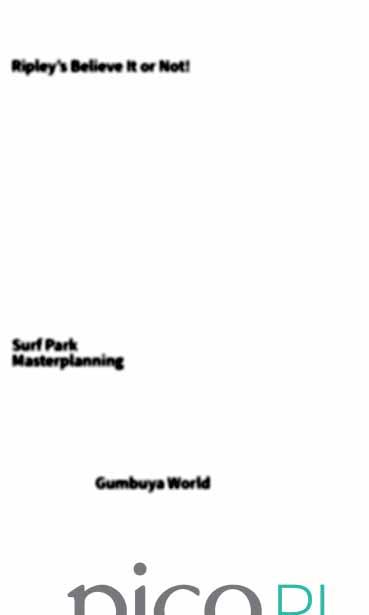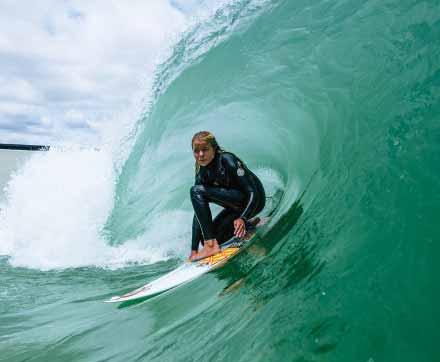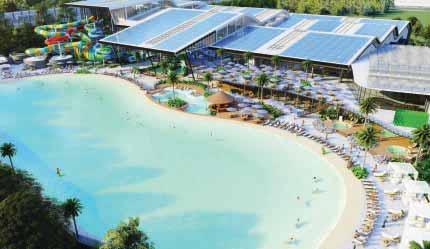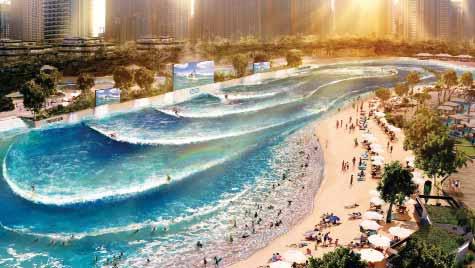
11 minute read
Making Waves
Brazilian surfer Filipe Toledo tests Wavegarden's The Cove technology. Credit: Wavegarden.
Noel Dempsey and Nigel Benton assess the potential of destination surf parks
Advertisement
Assuming the Tokyo Games go ahead in July, surfing will be one of over 30 sports making its Olympic debut.
The sport’s long-awaited arrival on the Olympic stage is widely seen as representing a massive opportunity to generate interest in surfing, with World Surf League Chief Executive, Erik Logan saying the potential is “historic”, representing “a truly transformative moment for surfing”.
Of course, more interest in surfing means more participants, and with Australia already having 2.5 million surfers many popular breaks can regularly be crowded.
While surfing doesn’t require infrastructure or the need to join a club (no entry fees are required!) being restricted to the coast and dependent on wave conditions has prompted a small number of entrepreneurs and innovators look to use technology to create perfect and consistent waves over the last decade or so.
However, this has not been without challenges.
While artificial wave rides like FlowRider stationary wave machines have proved relatively popular in waterparks, aquatic facilities and as standalone attractions, they have never truly become mainstream with Australia, perhaps surprisingly, never having more than half-a-dozen locations.
Commenting on the adoption of the FlowRider concept, Paul Chutter, President of WhiteWater, the home to FlowRider stationary wave machines, stated “FlowRider attractions, although not a true surfing experience, exist for a reason and we are happy they do.
“Maybe not as sought after in Australia, they do have a strong sport following around the globe, especially in areas without access to surf. Sheet waves offer another chance for people to get outside and partake in a board sport experience like wake surfing, snowboarding, or skating, and it gives first timers an easy way to experience the unique exhilaration of standing up on a board.”
In addition, surf creating artificial waves as pioneered by the now liquidated New Zealand-company ASR Limited proved unsuccessful – although reefs based around sunken vessels have proven a benefit for scuba divers.
Emerging as a solution, lagoon-style wave pools and destination surf parks are seen as having the potential to not only broaden surfing participation but to be the centrepiece of tourism and real estate developments echoing the way golf courses have driven commercial and residential developments in past decades. Kelly Slater Wave Company 11-time world champion surfer Kelly Slater has said that wave pools will take surfing mainstream, ‘democratising’ a sport that has only ever been available, by and large, to those lucky enough to live close to the coast.
Internationally, Slater’s own Kelly Slater’s Surf Ranch in California is perhaps the world’s best known facility.
With Slater’s wave generating technology now majorityowned by the World Surf League, the venue has already hosted WSL sanctioned events and is a regular stop on the pro tour.
With only seven other publicly accessible artificial wave pools in the world, Coolum on the Sunshine Coast has been advanced as a potential location for the first Kelly Slater attraction outside of the USA.

URBNSURF Melbourne uses Wavegarden technology.
Wavegarden Among operating facilities, URBNSURF surfing lagoon in the Melbourne suburb of Tullarmarine is the first (and currently only) facility of its kind in Australia.
Opened in January 2020, the $40 million fully functioning surf park produces beautifully shaped rideable waves, all day long, with 18 different wave settings varying in size from knee-high to well overhead, every aspect of which - size, shape, power and frequency - can be adjusted at the push of a button, to suit surfers of all abilities.
Using Wavegarden technology pioneered in Spain’s Basque region - with right-handers breaking on one side of the pool and left-handers on the other, with the two sides separated by a long pier - URBNSURF Melbourne is the first of several facilities of its type planned across Australia.
As URBNSURF founder and then Director Andrew Ross, who remains a major shareholder in the company, explained in 2014 the attraction set out “to completely change people’s views about what is possible with a wave pool.”
Ross, now a Partner with Aventuur, a US-based leisure developer, later advised “the best part about the Wavegarden technology is that it can cater for everyone across a range of surfing abilities - from those just learning, right through to elite athletes and their high performance training needs.”
URBNSURF’s other planned locations have included a site on Perth’s Swan River (currently in hiatus as a result of planning disputes) and at Sydney Olympic Park (for which renders have recently been released), which is scheduled to open in the summer of 2022/23. Surf Lakes Australia also has another working artificial wave lagoon on Queensland’s Capricorn Coast.
Operational since 2018, Surf Lakes Yeppoon has been a testing ground for Surf Lakes International’s artificial wave generating technology - which produces concentric waves generated by a gigantic plunger at the centre of the lake.
Having tested the technology, the team behind Surf Lakes Yeppoon are looking to expand their prototype into a year-round resort and visitor attraction with a $187 million development proposal.
Concept for Surf Lakes International’s wave lagoon at the heart of a residential development.










Operational since 2018, Surf Lakes Yeppoon has been a testing ground for Surf Lakes International’s artifi cial wave generating technology.
Seeking investors to back the installation of the technology at locations around the world, the company is now looking to make its prototype the centrepiece of a new outdoor recreational and active tourism hub.
Located near Mount Jim Crow between Yeppoon and Rockhampton, the $122 million first stage of the Surf Lakes Holdings’ proposed project would include a skate park, scuba hole, overflow lake, junior playground, solar farm and tourist park with 52 cabins and 60 camp sites.

Pico Play is a global leader in leisure and entertainment solutions delivering outstanding guest experiences across theme parks, water parks, surf parks, family entertainment centres, zoos and nature parks, aquariums and marine parks and public brand activations.
From business feasibility studies and concept planning to handover and operations management, there are countless steps involved in bringing a surf park to fruition.
Pico Play investigates additional revenue opportunities – from food and beverage and retail merchandise to recreational access and ancillary experiences – to entice guests to extend their stay and increase their spend.
Pico Play’s demonstrated success in delivering leisure and entertainment attractions, including water parks and theme parks, provides exceptional insight into those elements.
Pico Play Director, Darren McLean reveals “the technology needs to be robust, the water quality must meet health guidelines at all times and consistent additional revenue streams must be solidified before a surf park can even think of welcoming its first customers.”
A full range of design services, comprehensive modelling and spreadsheets and an intuitive understanding of branding, theming and experience is needed to ensure surf parks capture a broad cross-section of customers. Strategies for Success Sharing his insights on strategies for delivering successful artificial wave attractions and related surf park solutions, Darren McLean, Director of leading guest experiences consultancy Pico Play, advises “whether it’s a destination surf park, integrated into a resort, a residential anchor or a new theme park attraction, we are drawn to the concept of creating waves in unusual places.
“Pico Play is working on an inland surf park project in Asia, bringing a premium surfing experience to a region without any natural waves.
“On the flipside, we’re also working with Parkwood Village on the Gold Coast, arguably the world’s best surfing destination, because there is a strong existing demand for safe and consistent waves.”
McLean is mindful that surf parks must navigate a swell of business feasibility studies, market and customer research, concept and technology evaluation, master planning, investment prospectus, project delivery and operational management before anyone could catch a wave.
He explains “the reason Pico Play exists is to deliver fun and adventure for people across the globe and planning, designing, developing and constructing surf parks is a wonderful expression of what is in our core DNA.
“There is so much to consider across every aspect of operating an attraction and with surf park projects underway in Asia, Australia, USA and Europe, Pico Play is in the best position to provide a total solution and deliver outstanding guest experiences.”
One of these projects is a proposed surf park development at The Club at Parkwood Village on the Gold Coast where Pico Play have provided business advisory and feasibility services.
With the project currently being reviewed by Gold Coast City Council, Parkwood Village Managing Director, Luke Altschwager said he hopes to receive approval by year’s end with construction to begin in 2022 and the first waves to roll in by late-2023.
Altschwager commented “Pico Play has great experience at an international level across attractions and theme parks so with

URBNSURF Melbourne. Credit: URBNSURF/Ed Sloane.
the surf park industry being so new, we wanted someone looking at our project through a wider lens than just surf.
“Pico Play is not a traditional design or consulting firm, they have a clear operational history and practical boots-on-theground operating experience.
“They understand the leisure and entertainment business and they have passionate surfers on their consultancy team so they get the surf sector.
“Having a consulting firm that is holistic in nature and can look at all the commercial opportunities for our surf park is really helpful.”
McLean sees that success will come from understanding customer segments and their needs and developing a surf park model to meet each market, whether they surfed or not, noting “a lot of money goes in to building and operating a surf park and while surf sessions are the primary product, without additional revenues streams, the business won’t succeed.” Endless Surf The inland surf pool technology to be used at The Club at Parkwood Village will be WhiteWater’s new Endless Surf concept.
With WhiteWater having made its first surf pool at Disney’s Typhoon Lagoon Water Park in Florida, USA in 1989, Endless Surf features a scalable in size heart-shaped pool with a width of up to 300-metres that can provide a surf ride of up to 26 seconds.
Backed by patent protected proprietary programming, accessed through its Wave Doctor interface, Endless Surf can run multiple wave types at one time so that beginners, intermediates, and experts can surf alongside each other, providing huge operational flexibility.
The Club is among six Endless Surf projects officially announced around the world, including the Surf n’ Play Melbourne development.
Commenting on the The Club development, Paul Chutter, also the founder of Endless Surf, advises “the Gold Coast knows surf and surfers will want the most advanced techdriven surf experience that can accompany their sessions in the ocean. “Endless Surf provides just that, with unlimited wave creation potential and the most authentic aesthetic that will surround the action. Parkwood Village has major plans to create a vibrant community hub, surrounding surf, golf, relaxation, and lifestyle, and we are incredibly excited about the collaborative efforts coming to life from all parties.” Sustainability, fun and adventure
Surfers respect the planet and want to engage with an attraction that is considerate of its long-term environmental impact and operates ethically.
A smart approach to sustainability can also offer financial savings for surf park operators.
McLean added “the key to an attraction’s success is not only about making money on busy days, but not losing money on low attendance days.”
Mapping power consumption, harnessing solar power and programming waves for maximum efficiency across low, mid and high attendance days can all reduce power costs and energy footprints.
McLean adds “beyond the ‘wave’ is a need to create a total environment for your surfers and customers.
“Creating fun is at the heart of what we do and that is reflected in our approach to delivering surf parks.”
Away from these shores, Wavegarden attractions are operational in four locations (Switzerland, South Korea and two in the United Kingdom) while an American Wave Machines’ PerfectSwell artificial wave pool technology has been used at the soon to open Surf Stadium Shizunami in Japan.
With Global Industry Analysts estimating that the surf market will be worth US$9.5 billion as of next year, the potential is huge. Nigel Benton is Publisher at Australasian Leisure Management. Noel Dempsey is Business Director at Pico Play.

Endless Surf technology is planned for Melbourne’s Surf n Play Aqua Park. Credit: Pellicano.
WhiteWater’s new Endless Surf concept at the heart of a resort. PerfectSwell technology has been used at the soon to open Surf Stadium Japan.












